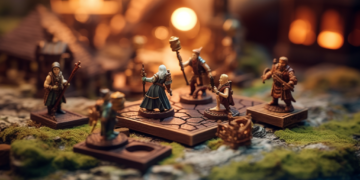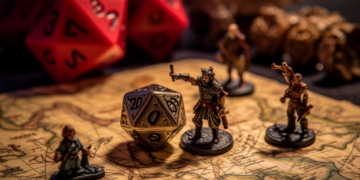
Armor is a fundamental aspect of Dungeons and Dragons 5e, governing the protection a character possesses against the onslaught of enemies. The game beautifully categorizes armor into different classes, each bringing its unique dynamics to the table. In this post, we’re going to focus on lightly armored characters, an intriguing breed that presents a unique blend of challenges and advantages. They’re the nimble rogues, the charming bards, and the resourceful casters, thriving in the lore-rich and mechanics-heavy world of D&D.
They tread softly, but their presence can be mightier than the heaviest armor. And sometimes, the most subtle dangers are the deadliest.
The Art of Being Lightly Armored in 5e
Have you ever wondered why certain classes prefer light armor? Classes such as rogues, bards, and certain casters, for instance? It is because of the emphasis these classes place on mobility, stealth, and initiative. Being lightly armored means being agile, being able to sneak past enemies undetected, and having the upper hand in terms of initiating combat.
Imagine a rogue, cloaked in shadows, silently moving behind enemy lines. Or a bard, charming their way through a crowd, their light armor barely making a whisper. That’s the art of being lightly armored in D&D 5e.
The Mechanics of Light Armor
Now, let’s dive into the mechanics of light armor. In D&D 5e, the Armor Class (AC) calculation for light armor is simple: it’s 10 + the character’s Dexterity modifier. This means that characters with high dexterity can greatly benefit from light armor. Additionally, light armor doesn’t impose disadvantage on stealth checks, making it the go-to choice for those who rely on stealth.
When it comes to weight, light armor is the least burdensome of all armor categories, allowing characters to carry more items or move more freely. This stark contrast between light armor and other armor categories is what makes it a unique and strategic choice for certain players.
Light Armor Options in D&D 5e
Being lightly armored in D&D 5e, opens up a treasure trove of possibilities. The game offers a wide array of light armor types, each with its own unique attributes and quirks. But how do these armors stack up against each other? And when should you choose one over another?
These are the questions we’ll be tackling in this section, as we explore the various light armor options available to your character. We’ll discuss their strengths, their weaknesses, and the situations in which they shine the brightest.
Padded, Leather, and Studded Leather
Let’s start with the basics: Padded, Leather, and Studded Leather armors. These are the bread and butter of any lightly armored character. Each of these armors offers a unique blend of protection, weight, and cost, making them ideal for different kinds of adventures.
Padded armor, for instance, is the lightest of the bunch, but it comes with a drawback of imposing disadvantage on Stealth checks. Leather armor, on the other hand, strikes a balance between weight and stealth, while studded leather armor provides an extra layer of protection at a slightly higher cost.
But don’t just take our word for it. Let’s take a closer look at the stats:
| Armor Type | Armor Class (AC) | Weight | Cost | Stealth |
|---|---|---|---|---|
| Padded | 11 + DEX modifier | 8 lbs | 5 gp | Disadvantage |
| Leather | 11 + DEX modifier | 10 lbs | 10 gp | — |
| Studded Leather | 12 + DEX modifier | 13 lbs | 45 gp | — |
Magical Light Armors
But what if you’re looking for something a little more… magical? Well, D&D 5e has got you covered. The game features a number of magical light armors that can truly change the tide of battle.
Take the Elven Chain, for example, a chain shirt that can be worn even by those who aren’t proficient with medium armor. Or the Glamoured Studded Leather, a studded leather armor that can magically alter its appearance to mimic any type of clothing. And who could forget the Mithral Armor, a light armor made from a rare and lightweight metal that doesn’t impose disadvantage on stealth checks?
Each of these magical armors comes with its own set of special abilities, adding a whole new layer of strategy and intrigue to your gameplay. So, whether you’re a nimble rogue, a charismatic bard, or a sly sorcerer, there’s a magical light armor out there that’s just perfect for you.
Playing Lightly Armored Characters
Have you ever wondered how it feels to dance around in the heart of battle, barely a scratch on your light armor, while your heavily armored companions lumber around like overstuffed scarecrows? A lightly armored character in D&D 5e is akin to a ballet dancer amidst a rugby match. Agile, graceful, and evasive, these characters rely more on avoiding attacks than absorbing them.
With a lower Armor Class (AC), lightly armored characters are often more susceptible to hits than their heavily armored counterparts. But is this always a disadvantage? Not necessarily. The key here lies in tactical positioning and smart use of the environment. Using cover, staying out of reach, and striking when the enemy least expects it, are all part of the game for these characters.
Moreover, consider the use of alternatives for damage mitigation. Shields, while not technically classified as armor, can provide a significant boost to your AC. Spells like Mage Armor or Shield can also be a godsend, transforming a squishy wizard into a formidable opponent.
Creating a Lightly Armored Character
Creating a lightly armored character is like crafting a finely honed blade. It requires forethought, precision, and a clear understanding of your character’s role within the party. The process is a delicate balance of selecting the right class, race, and background, and appropriately allocating ability scores.
Let’s start with the class. If you’re planning to be lightly armored, you’re likely considering classes like rogue, bard, or certain types of casters. The rogue, for instance, is a natural choice for those who favor agility and stealth over brute force. Bards, on the other hand, offer a balance between combat prowess and magical abilities. As for casters, many wizards and sorcerers prefer light armor or even no armor, relying on spells for protection instead.
The race and background you choose can also greatly impact your character’s effectiveness in light armor. For instance, races like the elf or halfling, with their bonuses to Dexterity, are excellent choices. Backgrounds that provide proficiency in stealth or offer additional movement options can also be beneficial.
As for ability scores, Dexterity is your best friend. It contributes to your AC, your ability to hit with ranged and finesse weapons, and several useful skills like Stealth and Acrobatics. But don’t neglect other scores. Constitution can help you survive when you do get hit, and depending on your class, other scores like Intelligence, Wisdom, or Charisma may be just as crucial.
- Choose a class that suits your playstyle and works well with light armor.
- Select a race that offers bonuses to Dexterity or other relevant abilities.
- Pick a background that complements your class and race choices.
- Allocate your ability scores with a focus on Dexterity, but don’t neglect other important scores.
- Consider the use of shields or protective spells if they’re available to your character.
- Plan your character’s development, including skill proficiencies and feat choices, around maximizing the benefits of light armor.
Iconic Lightly Armored Characters in D&D Lore
Ever wondered why some characters prefer the whisper of silk to the clank of chainmail? Why they choose lightness over protection, defying the traditional notion of a warrior? Let’s take a journey through the annals of D&D history and meet some of these iconic characters who have chosen to walk the path of light armor.
Drizzt Do’Urden: The Drow Ranger
When the name Drizzt Do’Urden is mentioned, one cannot help but think of the legendary drow ranger, skillfully moving through the shadows in his iconic mithral chain shirt. This light armor, rarely seen on the surface world, offers him the maneuverability he needs to execute his swift, deadly attacks while providing essential protection. Drizzt’s choice of light armor is a testament to his dexterity and combat strategy.
Vox Machina: The Adventuring Party
Vox Machina, the beloved adventuring party from the world of Exandria, also hosts a member known for her light armor. Vex’ahlia, the half-elf ranger, often dons leather armor, a choice that reflects her need for stealth and speed during her scouting missions. Her story is a reminder of how light armor can play a critical role in a character’s journey, defining their skills and combat style.
The Role of Light Armor in D&D Storytelling
But what does light armor mean for the story? How can a choice of armor affect the narrative and character development? Let’s unveil the role of light armor in D&D storytelling.
Armor as Character Identity
Armor in D&D is more than just a defense mechanism; it’s a part of a character’s identity. Light armor, in particular, often symbolizes a character’s agility, stealth, and cunning. It’s a reflection of their abilities and their approach to combat and adventure. Does your character don a set of fine leather armor? They might be a cunning rogue, relying on stealth and wits over brute force. This choice of attire can add depth to your character, making them more than just a collection of stats.
Armor as a Plot Device
Armor can also serve as a plot device, influencing the narrative and leading to exciting, unexpected situations. The limitations of light armor, such as its lower protection, can create challenging scenarios that push characters to their limits and force them to think creatively. Can your rogue sneak past the guards undetected, or will they have to face a dangerous confrontation? These are the thrilling moments that make D&D such a captivating game.
The Future of Light Armor in D&D
As we gaze into the crystal ball, what could the future hold for light armor in D&D? Let’s make some educated guesses.
-
More magical light armor: Magic items are always a hit among players, and expanding the roster of magical light armor could add another layer of excitement to the game.
-
Expanded light armor options for classes: It would be interesting to see more classes getting access to light armor, especially those that traditionally rely on heavier armor.
-
Improved light armor mechanics: D&D could explore new mechanics for light armor, such as enhancing stealth or evasion abilities, to make it a more appealing choice for players.
-
New lore around light armor: More stories and lore around light armor could deepen its role in the game and make it a more engaging part of character creation and development.






